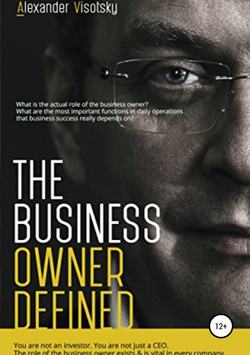A Job Description for the Business Owner

Реклама. ООО «ЛитРес», ИНН: 7719571260.
Оглавление
Александр Александрович Высоцкий. A Job Description for the Business Owner
Acknowledgements
Introduction
Chapter 1. The Business Owner’s Role
Chapter 2. The First Step to Competency
Chapter 3. The Main Goal and Purpose
Chapter 4. A Business Owner’s Personal Goals
Chapter 5. The Pursuit of Money
Chapter 6. Motivation
Chapter 7. Goal Promotion
Chapter 8. Establishing the Future
Chapter 9. The Product and the Brand
Chapter 10. Company Policy
Chapter 11. Technology
Chapter 12. The Strategic Management Cycle
Chapter 13. Finances and Assets
Chapter 14. The Duties of the Business Owner
Chapter 15. Co-Owners and Power
Chapter 16. The Code of a Business Owner
Afterword
Отрывок из книги
One might consider this book to be quite unusual. It is not about how to start a business, or how to earn millions. And it is not for those who dream only about creating their own businesses. Instead, the target reader for this book is someone who has already created his or her own business and continues to participate in the daily activities of the company.
Those who have founded their own businesses often fall into the trap of being too involved in or personally performing the day-to-day operations of the enterprise, only to find they cannot escape—sometimes for a lifetime. They set up companies to achieve their dreams, yet years later they feel like hamsters spinning on a wheel. To some extent, any founder of a company knows that his or her main purpose is not to solve daily operational issues personally. They understand that in focusing on strategic matters, they will be able to contribute much more to the business than by simply making sales or managing technical issues. There is a reason why most small to medium-size business owners cannot escape the daily grind and thus continue to be more like clerks at a grocery store, never “growing out of their first pair of pants.” One might say they become victims of their own success.
.....
Like many other enterprises, our company started from nothing. We renovated the office ourselves, tried to get our hands on some affordable office equipment, and had to come up with various schemes to get our first orders. For the first few months, we had to take part-time jobs as security guards because we did not have enough money to pay our staff. We even took turns spending nights at the office, cleaning it, and working as chauffeurs, couriers and porters. At the time, we were not even an authorized Apple reseller and service provider. But we were able to buy a shipment of Macintosh computers from an authorized dealer and, functioning as an intermediary, resell them to another authorized dealer. Our profit from the transactions consisted of two computers, which represented the main “capital” of our company. When we became authorized resellers, our first customers included some Western organizations like Motorola, the U.S. Peace Corps, and USAID, which were just opening offices in Ukraine. We were selling computers to offices and publishing houses, and by the end of our first year, we were the number one reseller in Ukraine. This was the height of our success. We were able to hire a sufficient number of personnel, and we had loyal customers and stable revenues. This was a time when the market was increasing steadily and the opportunities were almost limitless.
Since then, I’ve had many conversations with various company owners and have come to the conclusion that only a small number of them start out as Kshatriyas. Modern culture, at best, aims to raise obedient and hardworking executors, rather than develop leaders. Characteristically, a leader is fanatically loyal to his goals and persistent in their achievement. In his book, Grinding It Out: The Making of McDonald’s,1 Ray Kroc wrote:
.....